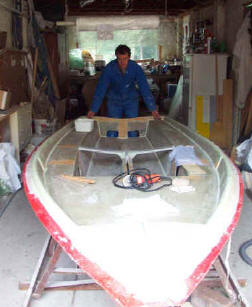 | |
Building a 125
Wooden boats
In the past most 125s were timber and amateur built. It is still possible to build your own boat, the Association sells electronic plan sets with fully documented building instructions for $50.00. A basic amateur built 125 will cost about $5,000. A professionally built 125 will cost approximately $8-9,000 depending on fit out.
Plans are available from the State Associations for building a 125 using the "stitch-and-glue" method of boatbuilding. Building with the stitch and glue method involves firstly "stitching" together the plywood panels using copper wire. Next the bulkheads are wired into place and internal members fitted with nails and epoxy glue. The "stitched" joins are then fibreglassed inside and out using fibreglass tape and epoxy resin. Finally, the decks and gunwales are fitted with epoxy glue, and the hull is ready to paint.
The plans are supplied with full size paper patterns for the plywood panels, and step by step building instructions. The Building Instructions have been recently revised and contain techniques used by experienced 125 home builders to build strong light hulls. The State Associations also supply aluminium mast, boom and spinnaker pole sections as well as aluminium rudder box kits and mast steps. Building a timber 125 over winter can be a very rewarding experience, and the majority of timber 125's have been home built.
Fibreglass boats
Glass reinforced plastic (GRP or Fibreglass), professionally built hulls have been available since 1993, and are now the preferred way to aquire a new 125. These may be purchased as a hull for fitting out yourself or they can be purchased fully fitted out. Also you can purchase a new hull to go underneath an old rig (if you have one)
125s are being built by amateurs in their garages all over Australia. We are one of the fastest growing classes in Queensland and most of the boats are still built by either parents or the sailors themselves!! Last year we had four new Queensland boats launched and another two are close to completion.Most 125 hulls and decks are built out of fibreglass and foam sandwich, with the gunwales and trimmings made out of wood, although some boats are now all fibreglass. While it sounds complicated and expensive but it is really quite easy to do and cheap. Timber boats are a bit harder to build believe it or not, and also require a fair bit of regular maintenance. My fibreglass boat needs only the wooden gunwales and trimmings to have coat of varnish once a year!!! That's it!
Foam sandwich boats are built by the following method using a mould or jig. There are two private moulds available in Queensland at a low cost for anyone to use.
Getting Started
You need:Once you have the required basic materials and a mould:
- Your materials (We can provide a list and even provide the materials themselves).
- A 125 Rules and Measurement Guide (pdf).
- One set of mylar patterns. Available for hire from the 125 Association. (Most moulds come with patterns).
- And a mould.
- The foam is cut into the sections of the boat using a set of patterns.
- The hull sections are then laid over the mould (which is an upside down hull on legs) and glued in place and then fibreglassed.
- Once dry, the hull (shell) is pulled off the mould and turned over and glassed on the inside. Tanks and seat tops are then glued and fibreglassed in place.
- Gunwales are glued around the boat.
- The centreboard case is made and fibreglassed into boat as well as other trimmings.
- The hull is faired, painted and rigged.
- Go sailing!
Prices
The price for all the materials for a foam sandwich 125 hull excluding rigging and fittings is about $1500. This includes resin, glass, foam, wood, paint etc.; i.e. everything for the hull itself.
The hire of the mould is $100.
Patterns from the 125 Association need a $40 deposit (Refundable).Help
John Anderson has built five 125s and helped with many more over the years. He can provide help and advice on the construction and getting started as well as information on fibreglass and foam construction for people who have never used it before.If you have any further inquiries please contact:
In Queensland: John Anderson on (07) 3396 9555 or by email
In other states, enquiries regarding plan sets should be directed to the National Measurer or President.
International (ie outside Australia) enquiries should be directed, via email, to the National Measurer or President.
| National 125 Association | admin | |
